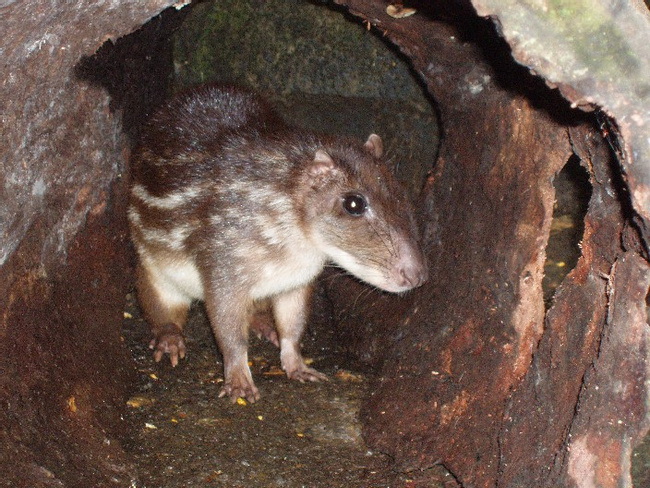
More about Paca
Habitat
The paca generally stays in moist lowland habitats but may also live in seasonally arid areas near permanent streams or bodies of water.
Range
Pacas range from southern Mexico to northern Argentina.
Physical Description
This nocturnal mammal is larger than its relative the agouti, and is twice the agouti's weight. Generally brown to black, with four lines of white dots on each side of body, the agouti lives solitarily with the exception of a mother rearing her young.
Biology and Natural History
Pacas like to eat in the darkest places possible. If they are encountered with a threat, they can sprint quickly, but more often escape danger by leaping away and staying still for up to 45 minutes. Since they do not usually run to escape, they can store fat for times of scarcity, whereas the agouti stores food in caches in the ground. In addition to leaping and freezing to escape danger, pacas have a thin outer layer of skin that can tear very easily in the jaws or claws of a predator, so it is difficult to grasp them before they get away. Pacas may also escape by running to a body of water and submerging themselves; they may have developed this behavior in response to the now rare bush dog (Speothos venaticus).
To deter potential predators, pacas also use vocal sounds and grind their teeth to make an incredibly loud, ominous noise. A male will also roar and fight to defend his territory. When fighting becomes necessary, pacas battle by standing head to head and gnashing at each other with their large incisors. Pacas do not use odor signals to communicate as extensively as agoutis do, but like agoutis, male pacas marks potential mates by spraying urine on them as part of the courtship ritual.
An adult female occupies an exclusive home range except for her mate and young offspring. One infant, or rarely, twins, are born furry with open eyes; newborns stay in a burrow dug by the mother or previously used by an armadillo. During the day the mother will cover the entrance with leaves.
Diet
Pacas mostly eat fruits, nuts, seeds, and during some parts of the year, plant vegetation.
Height/Weight
The head and body length is approximately 60-80 cm; their short, vestigial tail is 2 cm long. They weigh about 10 kg. Adult males are usually 15% larger than adult females.
Taxonomy
Order: Rodentia
Family: Dasyproctidae
Sources
Eisenberg, John. Mammals of the Neotropics, Vol. 1. The University of Chicago Press: Chicago, 1989.
Smythe, N. in Janzen, Daniel H. Costa Rican Natural History. Chicago: University of Chicago Press, 1983.
Wilson, D. E. in Janzen, Daniel H. Costa Rican Natural History. Chicago: University of Chicago Press, 1983.
Amy Strieter, Wildlife Writer
Photos:
Courses.washington.edu/tesc404/barbara/index.htm (1)
Paca Sightings
Similar Profiles
It's more than just having a good time or visiting beautiful places (although that's absolutely a part of it!), it's about being part of a unique experience that stays with you.



